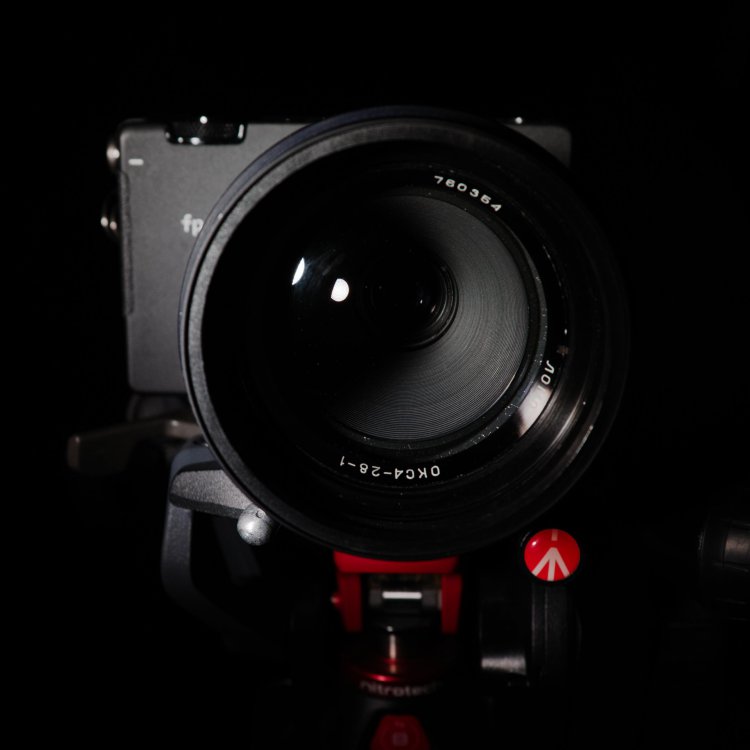-
Posts
321 -
Joined
-
Last visited
Content Type
Profiles
Forums
Articles
Everything posted by rawshooter
-
Do not do it. We have the shadow flickering bug that affects only some cameras - so in case this needs to be fixed in hardware, you will be out of luck. Besides, have you fully read the statement by Sigma? Any repair of a grey market camera does not only need to be paid out of your own pocket, but you'll also be charged $250 extra. That means that the money you saved will evaporate as soon as you need the camera to be serviced.
-
A camera with at least an APS-C/s35mm or better a full frame sensor, compressed internally recorded RAW (on the level of REDCode or CinemaDNG, not pseudo-RAW like BRAW or RAW without RAW controls like ProRes RAW) plus 10bit Log in a high-quality codec a full, manufacturer-supported workflow for color space transformation and ACES of the RAW and Log material good sensor stabilization good video autofocus compact form factor (not bigger than a typical DSLR/mirrorless) solid build (better than Blackmagics Pocket 4K/6K) large swivel display with touchscreen and touchscreen focus touchscreen menu system like Blackmagic's (instead of 1990s-style camera menus) high-quality internal audio recording (24bit or better 32bit float) obsoleting an external recorder for most tasks timecode support (via Tentacle Sync and similar systems) USB-C webcam support + smartphone monitoring USB-C charging and external powering Sony NP-F batteries
-
@Devon, I am not Andrew, but a gray market camera simply boils down to a camera without warranty, so you're getting a discount for the risk of likely having to pay repairs or replacements out of your own pocket if your copy should be defective. Postscript - Sigma very clearly states that their warranty does not include gray market cameras: https://www.sigmaphoto.com/article/important-information-regarding-gray-market-sigma-products/ "As of January 1, 2017, any product that is not imported by Sigma Corporation of America or purchased from an unauthorized Sigma USA Dealer will not be serviced under warranty regardless of the service required. The Sigma Corporation of America Service department will service these products for a minimum $250 charge in addition to the required parts and labor charges at the owner's expense."
-
I am aware of - and have tried myself - two solutions: a) a 3D-printed, very flimsy and plasticky d-mount to MFT adapter: https://www.shapeways.com/product/DSCYGUU7D/d-mount-to-micro-four-thirds-adapter . In my practical experience, most d-mount lenses can't be fully screwed into it; it doesn't reach infinity focus and doesn't provide a solid-enough base for the lens. (I.e. the lens isn't precisely aligned to the sensor, and you risk breaking the adapter only by pulling focus.) b) d-mount to c-mount adapters: https://fotodioxpro.com/products/d-c-pro - this is a simple step-up ring which doesn't compensate the flange focal distance difference between the two mounts (c-mount: 17.5mm, d-mount: 12.29mm). Adapted lenses won't reach anything near infinity either and can only be used as macro lenses.
-
There's currently no adapter for d-mount to Micro Four Thirds. If it's doable at all, it would need to be deeply recessed into the camera's mount since the flange focal distance of d-mount is 12.29 mm vs. 19.25 mm of Micro Four Thirds. For comparison, Pentax Q only has 9.2mm.
-
For getting rid of the resolution loss caused by Bayer interpolation, you only need 144% more resolution on the sensor than in the final image. This is why Arri designed the original Alexa sensor with 2.8K resolution for 2K final delivery. This conversely means that the Canon R5 won't deliver true 8K either - but actually "only" 5K optical resolution. For 4K delivery, 6K sensor resolution (i.e. the 24MP of the current, ubiquitous, run-of-the mill Sony full frame mirrorless camera sensor) is perfect. Btw., still only very few films are mastered in 4K. What you mostly see in 4K cinemas are blow-ups from 2K. Even "Bad Boys for Life", the currently highest-grossing mainstream Hollywood blockbuster, was mastered in 2K and mostly shot with 2K cameras. And, believe it or not, even IMAX Digital projection is "only" 2K.
-
The question is: Who actually needs 8K? Sports broadcasters, nature documentarists - maybe. I think @Andrew Reid wrote here some time ago that we already have enough (or even too much) resolution with today's cameras when filmic images are the goal. Beyond that, you're rather getting problems because you see every pimple on the face of your protagonist, because you can no longer film hand-held (since motion blur will kill your 8K resolution - it already kills 4K), because your 8K will only be visible with deep focus/depth of field (since shallow depth of field will blur out 90% of your 8K). So in order to make actual use of 8K, you'll easily end up shooting boring, static, oversharp and flat video images like in the bad old camcorder days... There's a reason why Arri never went beyond 2.8K on the Alexa's s35 sensors and even kept the full frame sensor of the Alexa LF at 4.4K (much less than even the 6K/24 MP prosumer Sony full frame sensors)... So of whom did Canon think as the target buyer for this camera? "Us", or some journalists who need a hybrid camera to deliver both hi-res stills and 8K video to their employers? Again, I don't wanna spoil anyone's enthusiasm, but just temper expectations before we get to see and test the real thing.
-
Well, the R5 is positioned by Canon as the mirrorless equivalent of the 5D whose last model cost over 4000 $/Euro when it was introduced. So I'd expect a similar price for the R5. I personally wouldn't pay that much money for a camera with such limitations. But of course everyone has their own needs and opinion.
-
There's one huge question mark: This camera has a 45 MP sensor - which even with the best and newest technology means a smaller pixel pitch, lower full-well capacity and more noise/worse low light/less dynamic range than a comparable 24 MP sensor. Canon's sensor tech now has a long history of rather dramatically trailing Sony's. (Just compare the 26 MP full frame sensor performance of the relatively new Canon EOS RP with Sony's 24 MP full frame sensor.) So Canon needs to have suddenly caught up or even leapfrogged Sony if the R5's sensor should have a comparable dynamic range and low-light capabilities to the A7iii, the Panasonic S1/S1H, the Nikon R6, the Panasonic S1/S1H and the Sigma fp (all of which use the same Sony sensor or variants thereof). In the worst case, this will be a camera developed for (a) stills photographers and (b) the (cancelled) Tokyo Olympics with its Japanese 8K broadcast standard, with 8K resolution and high megapixel count having been given priority over real-world performance. Which would also help Canon sell its C100/C200/C300 camera range despite all... Just sayin'. We can't really tell anything before the camera will be here and tested in the real world.
-
Now that I have an DCC8 dummy battery clone, working just fine with the Sigma fp, a question to other camera owners: Is there a way of safely and reversibly removing the battery compartment door of the camera?
-

Panasonic S1H gets anamorphic RAW and 6K RAW via HDMI to Atomos Ninja V
rawshooter replied to Andrew Reid's topic in Cameras
It's even more than that - RED's patents cover any form of compressed RAW video, including externally recorded RAW. Atomos pays major $$ to RED for being able to put (compressed) ProRes RAW into its recorders: https://www.atomos.com/press-releases/atomos-and-red-are-pleased-to-announce-a-royalty-based-licence-agreement -

Panasonic S1H gets anamorphic RAW and 6K RAW via HDMI to Atomos Ninja V
rawshooter replied to Andrew Reid's topic in Cameras
They did - patent exchange/cross-licensing. This is why the RED Komodo will have an RF mount and phase-detection autofocus. -

Fuji X-H2 - They can't decide whether to cancel it... Or?
rawshooter replied to Andrew Reid's topic in Cameras
The moniker "stills video" is a bit confusing though, because it meant - back in that time - that it was technically an analog video camera that captured still images. You couldn't record moving images with it. -

Fuji X-H2 - They can't decide whether to cancel it... Or?
rawshooter replied to Andrew Reid's topic in Cameras
DeepL with its scarily good machine translation AI (which isn't know yet to most American website operators like FujiRumors since it's a European website) probably renders the original Japanese interview better: Translated with https://www.deepl.com/translator -
Thanks for the info! - Doing further research on AliExpress, I saw that there are different DMW-DCC8 coupler clones sold in combination with NP-F battery adapters. This one here appears to be superior to others because it includes an 8.4 Volts converter (while other models just pass through the NP-F's native 7.4 Volts): https://nl.aliexpress.com/item/32677818991.html The basic NP-F adapter in this set is the same that SmallRig sells under its own brand for Blackmagic cameras - a good piece of hardware that, in my own experience, works very well.
-
How do you physically connect/adapt the NP-F970 to the Sigma fp? (Highly interesting to me and likely others, since these batteries are widely in use and literally powerhouses for their price.)
-
This is interesting, because on your copy it says 7.4 volts while the specification for both the original Panasonic BLC12 and the Sigma BP-51 is 8.4 volts. If it's possible to power the camera with only 7.4 volts, then you could likely also connect the dummy batteries to Sony NP-F batteries (which have 7.2 volts) - and this would open up wholly new possibilities for using the fp on long shooting gigs. But I leave it here, because at this point all this is speculative and we need to see whether and how it works in real life. P.S.: Is this a SmallRig cage in the background? Does it work well for you on your fp?
-
Are these batteries branded as BP-51 (Sigma) or as BLC12 (Panasonic) replacements? I'm asking because I'm still not sure whether the two battery types are really 100% compatible. (Fuji's early DSLRs, for example used nominally the same batteries as Nikon DSLRs from which their bodies were derived, but those batteries were incompatible nevertheless because of some internal chip.)
-
This is an interesting bit in the current times - that the fp can act as a standard webcam via its USB-C interface and be used for live streaming and teleconferencing without any extra hardware. So here comes the question: To do that, one would normally power the camera from an AC adapter - which is not included in the standard camera package. Sigma offers the SAC-7P as an extra camera accessory which consists of an AC adapter + a dummy battery for the camera. But it costs around $/EUR 80 and is hardly in stock anywhere. Since the Sigma fp's BP-51 battery is principally the same as Panasonic's DMW-BLC12 (yeah, the same battery as in the good old GH2...), I wonder whether one couldn't just buy a Chinese third-party BLC12 dummy battery + AC adapter which are readily available on a number of web shops (Amazon, AliExpress...) for only about $/EUR 28. This of course would be handy for other shooting situations, too. And since some of those BLC12 third-party dummy battery adapters work with USB power, this would mean that one should be able to power the fp with USB power banks! It sounds good in theory, but I wouldn't want to brick my camera if it doesn't work in practice... Has anyone here tried this out yet?
-
Interesting breakdown of how the Sigma fp's material behaves in Resolve and Premiere. 1st video: first available-light event documentary that I've seen made with the camera. 2nd video: first corporate video I've seen made with the camera.
-
With all due respect, the matter is more complicated: DNG (whether stills DNG or CinemaDNG) contains internal color matrixes. If a camera manufacturer doesn't provide raw specifications - like Sigma unfortunately does - then Raw developing software (no matter whether it's Lightroom, RawTherapee, Resolve, After Effects...) just interprets the raw DNG data based on the internal color matrixes. That is not optimal but works good enough for photographers who usually work in the sRGB or in the AdobeRGB color space. However, as film people, we're now used to work in wider color spaces - making proper use of the 10bit/OLED/DCP etc. screens that increasingly replace legacy 8bit/Rec709 HDTV - such as Aces, P3, Rec2020. However, this is the point where DNG without additional camera manufacturer support fails, and where NO software, no matter whether Resolve or anything else, can properly figure out how the RAW color values should be interpreted. So, in this case, it's upon Sigma to step up and help manufacturers across the board (no matter whether Adobe for AfterEffects, Blackmagic for Resolve, Assimilate for Scratch, Apple for FCPX...) and share information about the fp's native color space if they want to promote the fp as a serious cinema camera. Otherwise, we can't really make use of the full color spectrum captured by the fp, but will be limited by the Rec709 color space even when grading RAW.
-
@Andrew Reid, since I speak Dutch and you bought the camera in the Netherlands - were you aware of the fact that the dealer sold you a showroom model? (Because it had been listed as out-of-stock in its warehouse?)
-
Btw., the limitations and guesswork regarding the right color spaces for the CinemaDNG recorded by the Sigma fp apply to any software that can process CinemaDNG...
-
Naah, it's the opposite - Sigma doesn't provide a Log profile and corresponding color space yet (we have to wait till firmware 2.0 in summer), and doesn't provide any LUTs, Aces IDTs or other transformation functions for the fp's CinemaDNG so that in the meantime, we're limited to grading the material in Rec709 although the camera has a wider gamut/more color. It's likely because Sigma doesn't have any previous experience with video and digital cinema while the stills photography world still lives in sRGB (=almost the same as Rec709) or Adobe RGB at best, and thinks that paper prints (with their 5 stops dynamic range) are the Nirvana of image quality...
-
1. Sigma fp + Lomo OKC 4-28-1 (28mm T2, Super 35mm/APS-C). 2. Working as a teacher at a design school + photographer + video maker. 3. Since this site is based in the UK, I'll list my favorite British music: Daphne Oram, Brian Eno, The Pop Group, favorite sport: boxing, with huge nods to Tyson Fury and Anthony Joshua. Otherwise, privileged that my job is my hobby and vice versa. 4. Hopes for EOSHD: I most appreciate DIY/self-help/community mutual help coverage and discussions. The current thread on the Sigma fp (and how to work around its quirks) is a brilliant example, as is the thread on shooting RAW video on the EOS-M. My hope for the future of EOSHD is to further explore this direction. IMHO, progress in camera technology is slowing down, and we are almost "there". (For example, a mirrorless camera with an s35 sensor, clean 6400 ISO, good IBIS, good video autofocus, good color science, good manual controls, internal 10bit log + RAW recording would basically be "it"; which means that a camera like the Fuji X-T4 is 95% "there".) At some point, it might become more exciting to max out existing, cheaply available technology, than wait for the next great camera to come out. The EOS-M with MagicLantern Raw is a brilliant example. 5. There's better food, better climate, better street manners and now even better public services (transport, health...) in other parts of the world than in the Northern European country where I live; and as the Corona crisis shows, maybe generally smarter societies. (I'm particularly thinking of high-tech Asian countries such as Taiwan and South Korea.) But what I do miss elsewhere is my local arts community, aside from living in a stable part of the world with lower political threats/risks than elsewhere. 6. Must have been in 2013 when MagicLantern's RAW video recording on the Canon EOS 50D was reported here.





